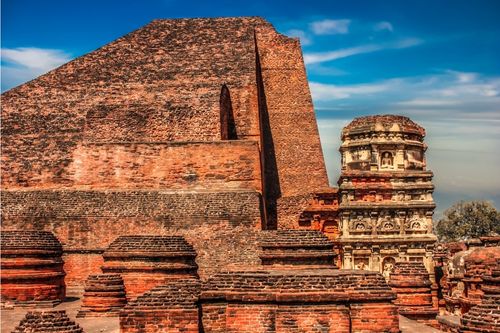Table of Contents
Nalanda Mahavihara or Nalanda University was established in 427 C.E. and flourished for nearly 700 years. It endured political upheavals, civilizational upheavals, religious warfare, and the emergence of intellectual giants for nearly a century before being destroyed by the Turks. Nalanda’s historic legacy extends back to the period of the Buddha (5th-6th centuries BCE) and Mahavira, the founder of Jainism. It was a fully residential institution with 2,000 faculty and 10,000 pupils. It attracted students from all around the world. Hence, it is known as the world’s first international university.
According to a later Tibetan tradition, Nagarjuna (the Buddhist philosopher of the 2nd-3rd centuries CE) began his studies there. Extensive excavations by the Archaeological Survey of India show that the monasteries were built during the Gupta period (5th century CE). Harshavardhana, the great 7th-century monarch of Kanauj (now Kannauj), is said to have contributed to them.
History

When the Chinese scholar Xuanzang visited Nalanda in the 7th century AD, it had 10,000 students and 2000 teachers. According to historical records, the University of Nalanda was founded during the reign of the Gupta monarch, Kumaragupta. Both Xuanzang and Prajavarman mention him as the site’s creator, as does a seal discovered there.
During his reign, the Chinese traveler Xuanzang visited Nalanda and wrote a detailed account of the disciplines studied there, as well as the basic characteristics of the community. A generation later, another Chinese traveler, Yijing, also published a detailed account of the life of the monks who stayed at the university.
According to historian Sukumar Dutt, the history of Nalanda University ‘falls into two main divisions—the first, one of growth, development, and fruition from the sixth century to the ninth. Liberal cultural traditions which were inherited from the Gupta age dominated it. The second, one of gradual decline and final dissolution from the ninth century to the thirteenth—a period when the tantric developments of Buddhism became most pronounced in eastern India.’
Libraries
The Nalanda library, also known as Dharma Gunj (Mountain of Truth) or Dharmagaja (Treasury of Truth) was the world’s most recognized repository of Buddhist knowledge at the time. Its library was supposed to contain hundreds of thousands of volumes, and it burnt for months after being set ablaze by Muslim invaders. The library was comprised of three main buildings, Ratnasagara (Sea of Jewels), and Ratnodadhi (Ocean of Jewel)
Curriculum
- Buddhist and Hindu, sacred and secular, foreign and native, courses were selected from every field of study.
- Students studied science, astronomy, medicine, and logic with the same zeal as they did metaphysics, philosophy, Samkhya, Yoga-shastra, the Veda, and Buddhist scriptures.
- They also studied foreign philosophy at Nalanda.
Few important facts about Nalanda University

- Nalanda was one of the world’s earliest residential universities, including student dorms. It was also one of the most well-known colleges in the world.
- The university was regarded as an architectural masterpiece, with a high wall and only one gate. Nalanda was comprised of eight distinct compounds and ten temples, as well as several meditation halls and classrooms. There were lakes and parks on the premises.
- The library was housed in a nine-story structure where precise copies of manuscripts were made. Nalanda University taught subjects from every field of study, and it drew students and experts from Korea, Japan, China, Tibet, Indonesia, Persia, and Turkey. The monastery is said to have owned 200 villages as donations under the reign of Harsha.
- In the 7th century, the Tang Dynasty Chinese traveler Xuanzang wrote extensive reports about the university. Xuanzang noted how the towers and forest of pavilions, harmikas, and temples seemed to ‘soar above the mists in the sky,’ allowing the monks to ‘see the birth of the winds and clouds’ from their cells.
- According to Xuanzang, ‘an azure pool winds around the monastery, ornamented with full-blown cups of the blue lotus; the bright red blooms of the exquisite kanaka hang here and there, while outside groves of mango trees offer deep and protecting shade to the occupants.’
- Many of the viharas at the Nalanda University ruins have a bow-marked floor; the bow was the royal sign of the Guptas.
Ruins
- A few dilapidated structures of Nalanda have survived.
- Surya Mandir, a Hindu temple, was found to be located nearby.
- The known and excavated ruins cover approximately 150,000 square meters, but if Xuanzang’s account of Nalanda’s extent is correlated with current excavations, nearly 90% of it remains unexcavated.
- Nalanda has been abandoned. Today, the nearest settlement is the village of Bargain.
- Bhikshu Jagdish Kashyap established the Nava Nalanda Mahavihara, a modern center for Pali (Theravadin) Buddhist studies, nearby in 1951. This
institute is now conducting an ambitious program of satellite imaging of the entire region.
Read more: Why Students Abandon Applications
Key takeaways
- Nalanda University was established in 427 C.E. and operated for nearly 700 years. It went through many political upheavals, civilizational upheavals, religious warfare, and the emergence of intellectual giants for nearly a century and then was destroyed by the Turks.
- Chinese travelers Xuanzang and Yijing visited Nalanda and wrote a detailed account of the disciplines studied, and the basic characteristics of the community, also wrote about the life of the monks who stayed at the university.
- The excavated ruins cover approximately 150,000 square meters, but when Xuanzang’s account of Nalanda’s extent is cross-checked with the recent excavations then nearly 90% still needs to be excavated.
Did you find this blog informative? If so, please share your thoughts in the comments section below. Click here to contact us for more information on the world’s first international university. We would be happy to assist you with your queries.
Liked this blog? Read next: Cornell University | Courses, Campus, and More
FAQs
Q1. Which university is the oldest Taxila or Nalanda?
Ans-Taxila University was one of the world’s oldest universities, and it was home to a number of prominent learned persons from many disciplines. Taxila’s strategic location and its popularity grew, but unlike Nalanda, it is not regarded as a university in the contemporary sense.
Q2. What is the second oldest university in the world?
Ans-Oxford University in England is considered the world’s second-oldest continuously operating institution. Some sources claim that teaching began in Oxford as early as 1096.
Q3. Is Nalanda University still running?
Ans-On September 1, 2014, it launched its inaugural academic session with 15 students in the School of Historical Studies and the School of Ecology and Environmental Studies. Initially established with temporary buildings in Rajgir, a modern campus spanning over 160 hectares (395.369 acres) is currently under construction.






